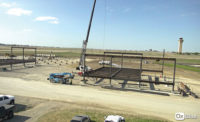Crews pushed three massive precast concrete boxes into place with hydraulic jacks underneath an active highway in Brevard County, Fla., during the week of March 29 as part of the $4-billion Brightline high-speed rail program that will extend the line to Orlando from Miami and West Palm Beach.
Officials believe it is the first time the box-jacking method, first used in the U.S. on the Long Island Rail Road Extension (ENR 9/2-9/19 p. 18), has been used under live highway traffic.
Granite Construction placed the rail tunnel as part of its $550-million, 35.5-mile portion of the program, says Michael Cegelis, executive vice president of development and construction for Brightline, the private operator of the system. The contractor proposed the method as an alternative technical concept in the bidding process. “It would otherwise take up to a year” to build the tunnel using conventional methods, he says.
After winning the bid in 2018, the team met with Petrucco, the Italian firm that developed the system, says C.J. Kaufman, Granite project engineer. The team used the system to complete an underpass in just nine days last fall, and “used the lessons learned there to tweak our design here,” he adds.
Crews installed temporary supports for the highway, then built the three box segments south of State Route 528 in Cocoa. “Then we started pushing boxes into place beneath SR 528. The overall jack length is 332 feet. … The overall weight is 24 million pounds,” says Kaufman.
It wasn’t possible to shut down 528 except for limited nighttime closures, so the team relocated eastbound traffic onto the westbound lanes. “We had the whole eastbound road to excavate. We pushed the underpass under it and excavated in front of it,” says Kaufman. “Then we got to a point where, to advance the underpass under the westbound road, we had to relocate at least one of those lanes to the former eastbound location.”
The concrete segment tops were lubricated so that a steel-plate system on the underbelly of the highway wouldn’t move along with the box slide, says Cegelis. “There is a truss system placed in front of the plates that resists as the box jack moves forward, so the steel plate system remains stationary with the roadway on top of it,” he adds.
The three precast concrete boxes weigh between 3,300 and 4,600 tons. The push was intended to progress at approximately 3 ft per hour, with up to 50 workers working 12 hours. “At the end of the day, overall progress was about 1.15 feet per hour,” says Richard Brown, Granite project director. Compared to the bridge placed last fall, “there was a lot more sand here. There were more clays.”
The unexpected conditions extended the two-week operation by about three days. The completed underpass is 31 ft high by 43 ft wide and will accommodate two trains side by side while eliminating the need for an at-grade crossing.
The overall Orlando rail extension project covers 170 miles from West Palm Beach to Orlando International Airport and is divided into four zones. Other major contractors include Middlesex, Wharton Smith and a joint venture of Herzog, Stacy Witbeck and Railworks.
The new alignment follows SR 528 on the south side from Cocoa to the airport. Cegelis notes that other innovative solutions on Granite’s job include a shoofly—a temporary bypass—used in order to build an underpass beneath I-95 without road closures and a 150-ft-long conveyer system carrying material over 528 that saved 27 miles of truck trips. Construction of the $2.7-billion phase is expected to be completed in late 2022.






